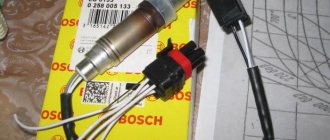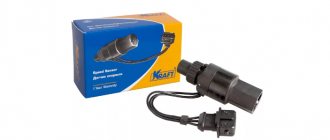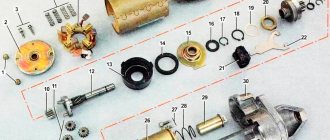The oxygen sensor (lambda probe) is part of the electronic engine management system. Its task is to comprehensively control one or more engine systems in order to:
- monitoring technical engine parameters;
- changes in the operation of individual systems if necessary, for example: when changing the temperature conditions of the engine, when pressing the accelerator pedal to different degrees, when changing torque, during a cold start, and so on;
- mode changes when switching to an alternative type of fuel.
A VAZ oxygen sensor is an electronic device that helps the control system monitor and adjust the operation of an internal combustion engine (hereinafter referred to as the internal combustion engine).
Like any element of a car, the VAZ 2110 oxygen sensor has certain resource capabilities. Subject to normal operation of the vehicle using high-quality fuel and timely maintenance, as well as in the absence of frequent overloads and overheating of the internal combustion engine, one sensor will work from 4 to 7 years. During this period, the car owner will travel on average from 100 to 150 thousand kilometers.
The VAZ oxygen sensor contributes to the stable operation of the engine and helps it maintain the required technical parameters in different modes, determining the quality of the exhaust gases and transmitting the corresponding signal to the electronic engine control unit.
What is this?
An oxygen sensor or lambda probe for a VAZ 2110 is a device that is located on the exhaust manifold in the exhaust system of your car.
Data transmitted from the device allows the electronic control unit to optimize the composition of the air-fuel mixture. If the mixture entering the combustion chamber turns out to be lean or excessively rich, the sensor reports this, after which the mixture begins to be adjusted.
How to check the lambda probe on a VAZ - malfunction of the oxygen sensor
The Internet is simply replete with various discussions on forums and social networks about problems with an oxygen sensor or lambda probe. In fact, the lambda probe is a very important part.
After all, it is directly involved in mixture formation, which means that it affects such vehicle parameters as fuel consumption and dynamics.
And at the same time, its malfunction may not show itself in any way, the check will not light up, it lights up only if the lambda has already completely closed, but the oxygen sensor may simply give “incorrect readings” to the engine control unit.
And the car owner will not even guess why his consumption is increased or his car is “stupid.” So I suggest that you take the diagnosis of the oxygen sensor very seriously, especially if you notice any of the symptoms described above.
A modern lambda probe installed on a VAZ has 4 outputs: ground, signal output and two for the heater.
The lambda probe readings are best read with special software by connecting to the diagnostic bus of your car. This is the only way to know the waveform it produces and the rate of change of these signals.
First of all, when diagnosing the sensor, remove the connector from it and use a multimeter to check the presence of voltage on the signal wire from the ECU; it should be 0.45 volts. By the way, if this voltage deviates from the given value, most often in the direction of increase.
This can be cured by installing an additional resistor. You can calculate the required resistor value as follows:
1) take an adjustable resistor, such as for volume control
2) We connect it in series to the lambda signal power circuit.
3) connect the tester and twist the resistor until the voltage reaches 0.45-0.46 volts.
4) start the car, check, if everything is OK, measure the resistance on it and select a regular resistor of the appropriate value. By the way, the resistor will not heat up; there is no high load.
Now let's figure out how the lambda probe itself works.
When the amount of oxygen in the exhaust increases, the voltage at the oxygen sensor signal output decreases to 0.1 volt. And if there is little oxygen, then the voltage, on the contrary, increases to 0.9 volts. I think the principle of lambda operation is now clear to you. So let's look at the most common problems with lambda.
For example, the check light came on and the on-board computer or scanner gave us error P0131 - “Low signal level of oxygen sensor 1.” This does not mean that the lambda has failed and you need to run for a new one and urgently change it.
This first of all means that the lambda probe has detected a lean mixture! It is not difficult to make sure that the mixture is really lean - just pinch the return line or spray a little gasoline from a syringe directly into the intake manifold. The gauge should indicate that the mixture is too rich.
If it shows, everything is ok, the mixture is rich, and the oxygen sensor sees this, it is working. The second option should also be noted - the error reports that the outside sensor has detected a mixture that is too rich. We create an artificial air leak. To do this, just remove the vacuum hose and monitor the voltage on the lambda. Must fall.
If it falls, again, the lambda is working. And finally, the last option - you make the previous two attempts to influence the lambda readings, and the voltage invariably remains within 0.45 volts. Here we have arrived, the lambda probe has “died” and needs to be changed, with no options.
Well, let’s add to the article, since the lambda probe reacts precisely to the amount of OXYGEN, if there is a “suction” of this very oxygen from the outside in the exhaust system, it will give a signal to the computer to enrich this mixture, just don’t play around. Therefore, be as careful as possible when checking the system and its tightness! Good luck to everyone on the roads and good sensors on your car!











